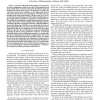Free Online Productivity Tools
i2Speak
i2Symbol
i2OCR
iTex2Img
iWeb2Print
iWeb2Shot
i2Type
iPdf2Split
iPdf2Merge
i2Bopomofo
i2Arabic
i2Style
i2Image
i2PDF
iLatex2Rtf
Sci2ools
CN
2004
2004
On characterizing BGP routing table growth
The sizes of the BGP routing tables have increased by an order of magnitude over the last six years. This dramatic growth of the routing table can decrease the packet forwarding speed and demand more router memory space. In this paper, we explore the extent that various factors contribute to the routing table size and characterize the growth of each contribution. We begin with measurement study using routing tables of Oregon route views server to determine the contributions of multi-homing, load balancing, address fragmentation, and failure to aggregate to routing table size. We find that the contribution of address fragmentation is the greatest and is three times to that of multihoming or load balancing. The contribution of failure to aggregate is the least. Although multihoming and load balancing contribute less to routing table size than address fragmentation does, we observe that the contribution of multihoming and that of load balancing grow faster than the routing table does and ...
| Added | 16 Dec 2010 |
| Updated | 16 Dec 2010 |
| Type | Journal |
| Year | 2004 |
| Where | CN |
| Authors | Tian Bu, Lixin Gao, Donald F. Towsley |
Comments (0)

